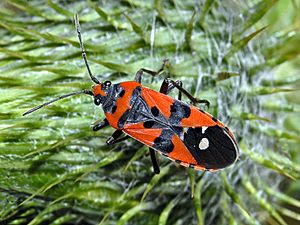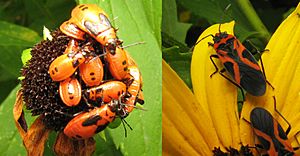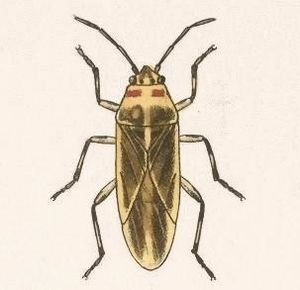Lygaeus facts for kids
Quick facts for kids Lygaeus |
|
|---|---|
 |
|
| Lygaeus equestris | |
| Scientific classification |
|
| Kingdom: | Animalia |
| Phylum: | Arthropoda |
| Class: | Insecta |
| Order: | Hemiptera |
| Family: | Lygaeidae |
| Subfamily: | Lygaeinae |
| Genus: | Lygaeus Fabricius, 1794 |
Lygaeus is a group of small insects often called seed bugs. They belong to a larger family of bugs called Lygaeidae. These bugs are known for eating seeds from plants.
There are more than 60 different kinds, or species, of Lygaeus bugs found around the world. Many of them have bright colors, like red and black, which can warn predators that they might not taste good.
Contents
What are Lygaeus Bugs?
Lygaeus bugs are a type of true bug. This means they have a special mouthpart that looks like a straw. They use this straw to suck liquids, usually from seeds. They are part of the insect order called Hemiptera, which includes many other bugs like cicadas and aphids.
Where Do Lygaeus Bugs Live?
These bugs can be found in many different places. They live in various habitats across the world. Some species prefer open fields, while others might live in forests or gardens. They are often seen on plants where their food sources, like seeds, are plentiful.
What Do Lygaeus Bugs Eat?
Lygaeus bugs are mostly seed eaters. They use their straw-like mouthparts to pierce the outer shell of seeds. Then, they suck out the nutrients from inside. Some common plants they feed on include milkweed, sunflowers, and other wild plants. This diet helps them grow and get energy.
Different Kinds of Lygaeus Bugs
There are many species within the Lygaeus group. Each species has its own unique features. For example, the Lygaeus equestris is known as the black-and-red bug. Another one is the Lygaeus kalmii, often called the small milkweed bug. These names often describe their appearance or the plants they like to eat.
Scientists have identified 69 different species of Lygaeus bugs. Some of these species are still alive today. Others are known only from fossils, meaning they lived a very long time ago. Studying these different species helps us understand how insects have changed over time.
See also
 In Spanish: Lygaeus para niños
In Spanish: Lygaeus para niños



